Want to master the theory, chord progression and arrangement framework behind unique and memorable electronic music? Check out Songwriting For Producers.
Chord progressions are the staple of any good song.
In fact, they can make or break a track.
But they’re hard to write, let alone write well (especially if you don’t know music theory).
Once you have a basic understanding of the different types of chords and how they sound, it’s time to start writing chord progressions.
And no, you don’t have to play piano or guitar to write them well.
In this chord progressions article, we’ll cover:
- The concept of diatonic chords and how they make your track sound great
- Creating different moods with both major and minor chords
- How to tell a story by moving between different types of chords (stable, movement and tension chords)
- Some real-world song examples and what makes them work so well
- How to understand chord notation and write chords super fast
Let’s start with diatonic chords.
Want this entire article summed up in one PDF? Check out our cheat sheet below 👇
Streamline your workflow with our Free Chord Progression Cheat Sheet 🎹
Get our one-page guide containing all the essentials you need to write catchy chord progressions – including chord motion charts, chord voicings and common progressions 👇
Diatonic Chords
First, you should understand the concept of diatonic chords.
Diatonic chords are chords that naturally occur in a key.
I’ll explain this with an example.
Let’s say we’re in the key of C, which contains the notes C, D, E, F, G, A, and B.
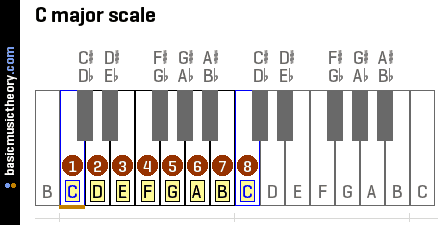
Is the C major chord (C – E – G) diatonic to the key of C? Yes, because all of the notes in a C major chord naturally occur in the key of C.
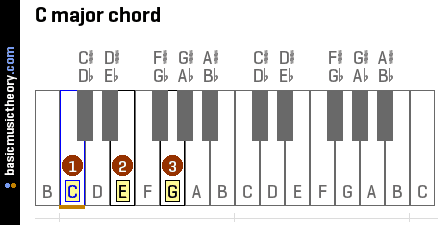
Is the G major chord (G – B – D) diatonic to the key of C? Yes, because all of the notes in a G major chord naturally occur in the key of C.
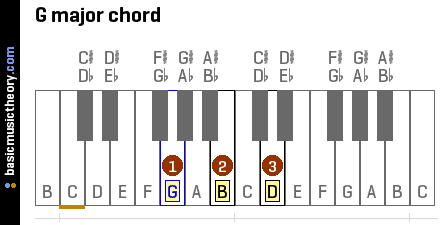
What about D major (D – F# – B)? No, because F# is not in the key of C.
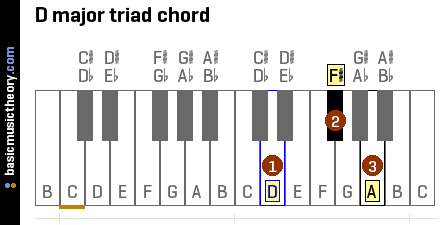
So C major and G major are diatonic chords in the key of C, but D major is not.
—
Why should you care about diatonic chords?
Since diatonic chords fit naturally in a key, they will naturally sound good together.
Think about it: If you’d like to write a chord progression in the key of A minor, wouldn’t it make sense to know what chords naturally fit in that key?
Of course.
Every major and minor key will have seven diatonic triads.
In other words, every major/minor key has seven chords that naturally occur in that key and sound good together.
There is a formula to determine these chords. For major keys, it’s as follows:
| Major Key | |
| 1 | Major |
| 2 | Minor |
| 3 | Minor |
| 4 | Major |
| 5 | Major |
| 6 | Minor |
| 7 | Diminished |
The number refers to that note’s position in the scale. In the key of C, C is the 1st note, D is the 2nd note, E is the 3rd note, and so on.
This means the one chord in a major key is major, the two chord is minor, the three chord is minor, and so on.
How can you use this information?
If you know the notes of a key, you can determine the seven triads that are diatonic to that key. Simply plug a note into the chart, and it will tell you the quality of that chord (major, minor, diminished).
Diatonic chords example
Take D Major. D Major contains the notes D – E – F# – G – A – B – C#. Using the chart above, we can find the seven chords diatonic to D Major. They are:
- D major (1)
- E minor (2)
- F# minor (3)
- G major (4)
- A major (5)
- B minor (6)
- C# diminished (7)
This will make writing a chord progression easier since we have 7 chords that we know work well together.
You may have noticed I put the chord number in parentheses. Just as we label notes based on their position in the scale, we do the same with chords.
In D Major, the one chord is D major, the four chord is G major, and the six chord is B minor. You’ll commonly see these represented by roman numerals. In the key of D, A major is the “V” (i.e. five chord).
Pro Tip: When using roman numerals, uppercase and lowercase letters are used to represent major and minor chords, respectively.
Minor keys also have a formula to determine their diatonic chords. It’s as follows:
| Minor Keys | |
| 1 | Minor |
| 2 | Diminished |
| 3 | Major |
| 4 | Minor |
| 5 | Minor |
| 6 | Major |
| 7 | Major |
Now that you know what diatonic chords are, it’s time to start writing.
—
The first two steps when writing a chord progression are:
- Choose a key to write in
- Figure out the chords in that key
(Disclaimer: you can start writing without knowing the key, but it’ll be harder, especially if you’re new to music theory)
Which key should you write in? It’s up to you. Each key has it’s own emotional quality, which you can read about here. Many artists have a few keys they consistently write in (myself included). Once you’ve determined a key, the next step is to figure out it’s diatonic chords.
After you’ve finished these steps, it’s time to start writing.
—
The next portion of this article is broken up into two sections:
- How to write a chord progression
- How to write a catchy & memorable chord progression
If you’re brand new to writing chord progressions, continue reading from here. If you’re familiar with how to write chord progressions but want to improve your skills, you can skip to the next section.
How to write a chord progression
Once you’ve finished the first two steps, the simplest way to write a chord progression is to choose any four diatonic chords and play them in succession.
An easy way to do this is to create a 4 bar loop with 1 chord per bar.
Let’s try it.
For this section, we’ll keep things simple in the key of C.
Take the following four chords: C major, G major, D minor, and F major (which all are diatonic to C).
I plugged them into my piano roll, and this is what it sounds like:
Audio Player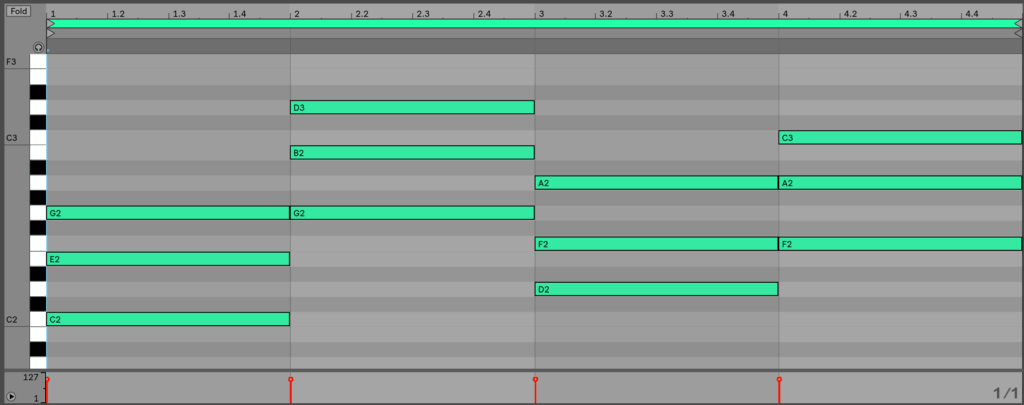
If you’re brand new, this technique is great: choose a key, find the chords in that key, then arrange them in a loop.
Let’s try another: G major, E minor, A minor, and D minor.
Audio Player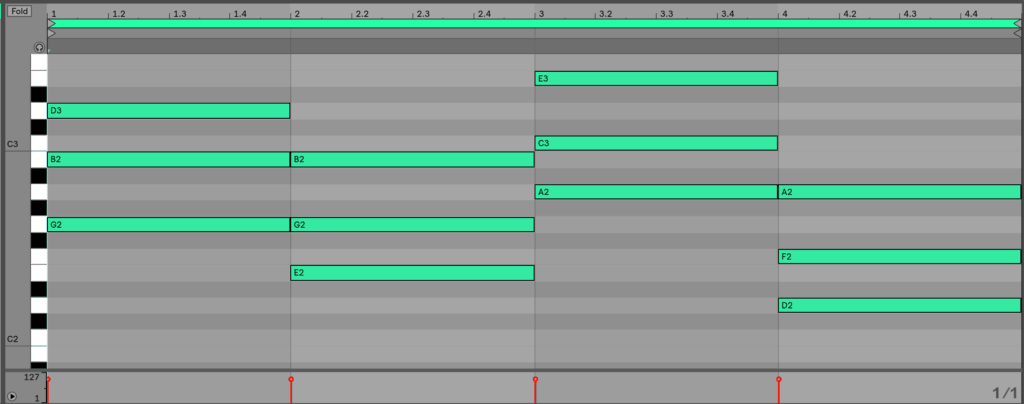
It still works, but it doesn’t sound as good as the first progression. Why? We’ll discuss this in the next section
—
At its most basic level, this is how you write a chord progression: arrange a series of chords in a row.
Beyond this, there are a series of guidelines you can follow to make more interesting and exciting progressions.
Streamline your workflow with our Free Chord Progression Cheat Sheet 🎹
Get our one-page guide containing all the essentials you need to write catchy chord progressions – including chord motion charts, chord voicings and common progressions 👇
How to write a catchy & memorable chord progression
Now that you have a basic understanding of how to write a chord progression, how do you write one that actually sounds good?
A memorable chord progression needs to tell a story.
What do I mean?
Think of a chord progression like a movie. Movies need a logical start and finish, and there needs to be some type of development.
When writing a chord progression, it’s essential to have a clear start and finish. There also needs to be a degree of emotional development and movement.
Playing a single chord four times in a row doesn’t evolve a track: it’s just the same chord over and over. Rather, piecing together distinct chords creates emotional development that engages and excites the listener.
You can think of chords like the building blocks of a story: some will sound happy, some will sound anxious, and others will sound restless. As a musician, it’s your job to put these pieces together in a way that makes sense.
When building chord progressions, there are two main components you need to keep in mind:
- What role does each chord serve in the key?
- How do chords sound when played one after the other?
Let’s dive into both of these questions.
(For now, let’s stick to the same pattern as above, where we have a 4 bar progression with 4 chords, each 1 bar long. We’ll also be sticking with our diatonic chords.)
1. What role does each chord serve in the key?
Within each key, there are seven diatonic triads to choose from. Each chord serves a distinct purpose: some will sound like “home”, some will sound suspenseful, and others will sound happy but anxious.
Without getting too technical, let’s discuss the role of each chord in a major key:
One (I) – Stable. Feels like “home”. Great to start on.
Two (ii) – Movement. Creates a feeling of change, wants to move somewhere else.
Three (iii) – Stable. Less stable than the I chord.
Four (IV) – Movement. Creates a feeling of change, wants to move somewhere else.
Five (V) – Tension. Wants to move somewhere else fast. Great to end on.
Six (vi) – Stable. Less stable than the I chord.
Seven (viiº) – Tension. Wants to move somewhere else fast.
Example: Start with the one chord, which feels like home. Move to the six chord, which is stable but a bit tense. Move to the two chord, which creates a sense of change. End on the five chord, which wants to be resolved back to the one (start).
These aren’t steadfast rules, but they are a great starting point.
2. How do chords sound when played one after the other?
When you combine chords in a progression, certain arrangements will sound better than others. Some chords sound great played together, while others sound just okay.
Thankfully, there are guidelines that tell you which chord should come next.
Let’s look at the common chord motion in a major key (i.e. what chord will sound good next).
One (I) -> Any chord
Two (ii) -> Five (V) or Seven (viiº)
Three (iii) -> Six (vi)
Four (IV) -> Five (V) or Seven (viiº)
Five (V) -> One (I) or Three (iii)
Six (vi) -> Two (ii) or Four (IV)
Seven (viiº) -> One (I) or Three (iii)
Are these the only chord changes you can make? Of course not. These rules tell you where a chord sounds like it should go next.
On the other hand, you may want to tease the listener and don’t want the progression to resolve right away. These rules are a great starting point, but always make decisions in context.
Here are a two charts that detail the chord motion for major and minor keys:
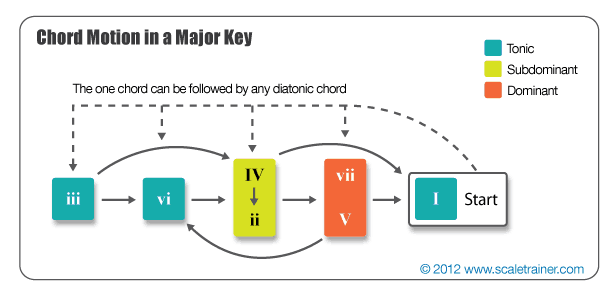
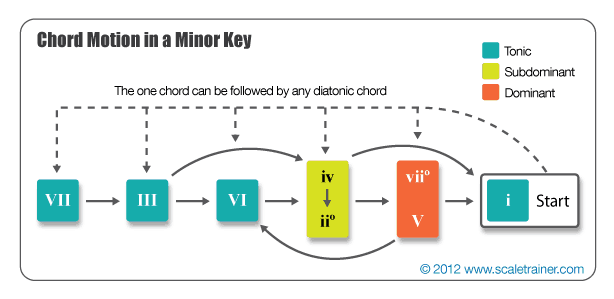
Let’s recap what we’ve discussed so far:
- Diatonic Triads:
- Every key has seven diatonic triads. These chords naturally occur in the key.
- There is a formula to find the diatonic triads of major/minor keys.
- Chord Progressions:
- An easy way to build a chord progression is to create a 4 bar loop with 1 chord per bar.
- Chord progressions need a logical start/finish, and should have a degree of development and movement.
- Each chord in a key serves a unique purpose: some are stable, some are tense, others are restless.
- Chord progressions tend to a follow a certain pattern. There are rules that explain common chord movements (for example: V -> I always sounds good).
Using all of this information, you will be well on your way to writing stronger and catchier chord progressions.
However, everything we’ve discussed so far is just theory, not practice.
The best way to improve your skills is to study popular chord progressions. Understanding how and why they work will allow you to apply the techniques used in your own productions.
Keeping this in mind, let’s look at a few common chord progressions.
Common Chord Progressions
Here I’m going to list out a few of the most common types of chord progressions you’ll find in pop, EDM and other types of music.
I → V → vi → IV
In the key of C Major, this progression is: C – G – am – F
Audio Player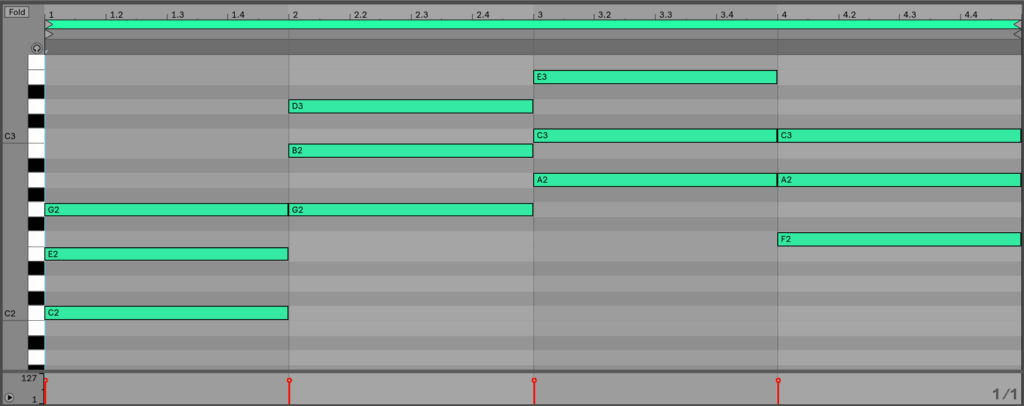
Songs that use this progression:
Pair of Dice by Tiesto and Allure
4 Chords by Axis of Awesome (Video parodying how common this progression is)
I → V → IV → V
In the key of C Major, this progression is: C – G – F – G
Audio Player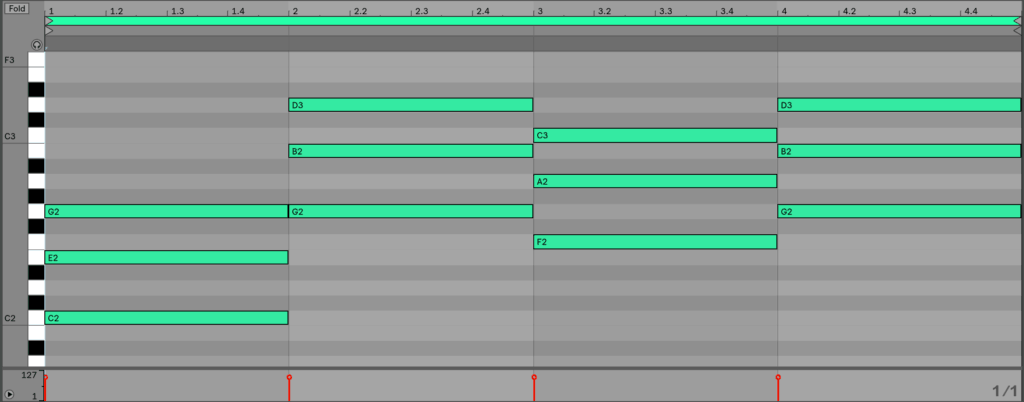
Songs that use this progression:
All The Small Things by Blink-182
I → vi → IV → V
In the key of C Major, this progression is: C – am – F – G
Audio Player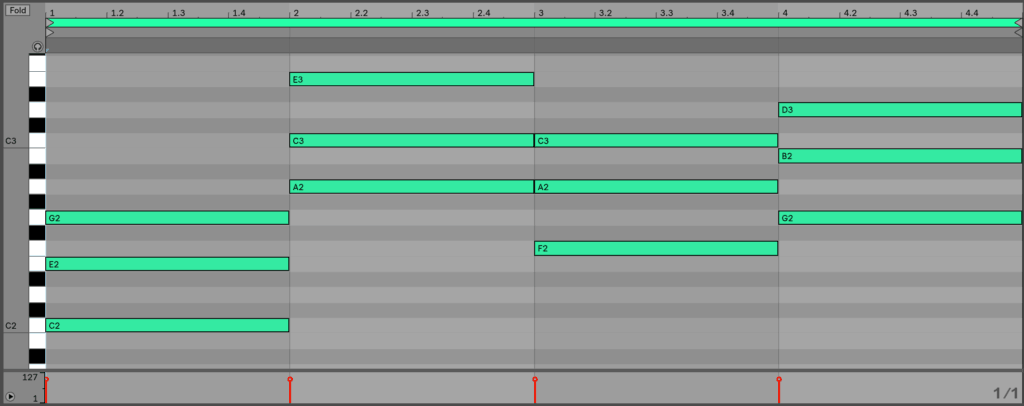
Songs that use this progression:
In the Aeroplane Over the Sea by Neutral Milk Hotel
Recommended: How To Analyze Music Using the 5-Point Technique
I → IV → vi → V
In the key of C Major, this progression is: C – F – am – G
Audio Player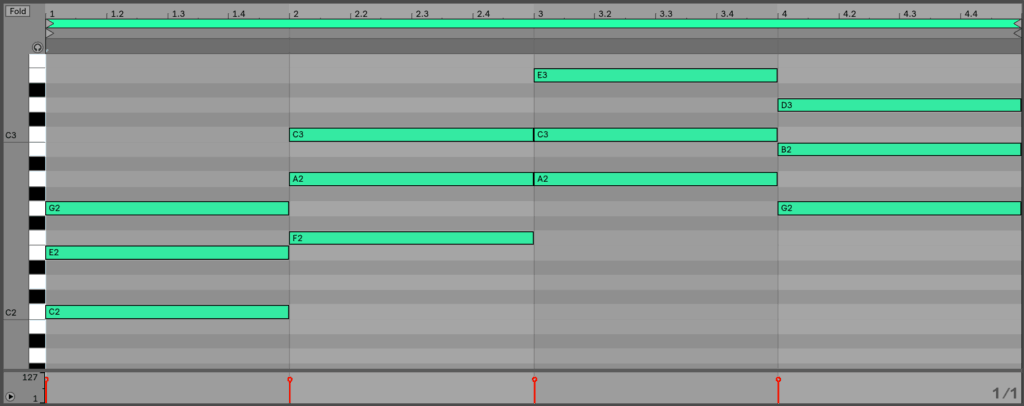
Songs that use this progression:
I → V → vi → iii → IV
In the key of C Major, this progression is: C – G – am – em – F
In the example below, I’m playing C – G – am – em – F – C – G – G
Audio Player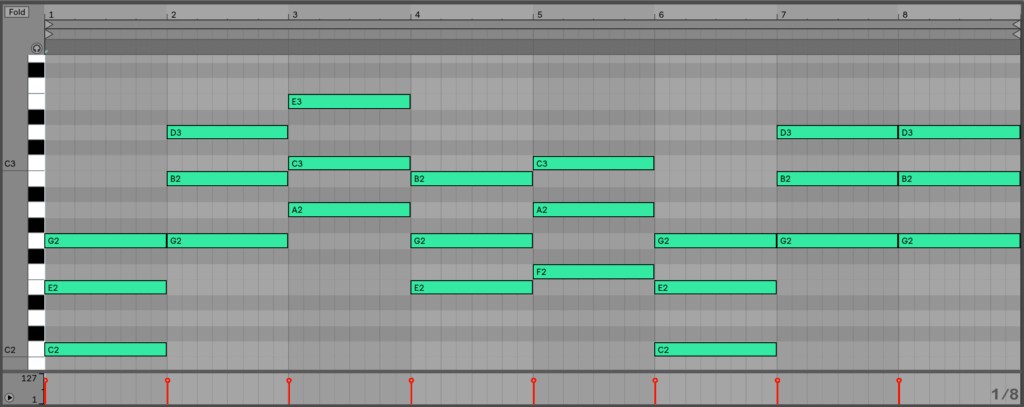
Songs that use this progression:
Under The Bridge by Red Hot Chili Peppers
What Do I Do Now?
Now that you’ve learned fundamentals of writing chord progressions, the next step is to practice. Take what you’ve learned and go practice writing!
I recommend having dedicated sessions that focus on writing chord progressions. This will allow you to dive deeply into the topic, helping you strengthen and sharpen your songwriting skills.
For simplicities sake, I’ve kept our options quite limited for this article. In reality, professional songwriters will break many of the rules I’ve laid out.
This leads to my last rule: trust your ears.
If you don’t know why a chord fits, but it does, leave it! Just like you’d experiment with a new synth, play around with the chords in your piano roll and try out new ideas. In the end, always go with what sounds best.
On top of that, always try looking and see if you can get access to the MIDI of your favourite songs. Here’s a great pack from Basic Wavez with 50 of the most famous EDM Chord Progressions in MIDI format.
Lastly, if you want to learn about chord progressions used by artists such as Flume and Madeon, check out my Track Breakdown article series.
Any questions? Email me at connor@edmprod.com.
Streamline your workflow with our Free Chord Progression Cheat Sheet 🎹
Get our one-page guide containing all the essentials you need to write catchy chord progressions – including chord motion charts, chord voicings and common progressions 👇


